This conversation took place the week after the release of the art-world comedy-horror flick, Velvet Buzzsaw. It debuted on Netflix on Jan. 31.
(Spoiler alert: many, many spoilers ahead.)
Neil Fauerso: So, this movie was pretty bad. I wasn’t expecting it to be particularly smart or cutting. Dan Gilroy, who wrote and directed it, has some very powerful dumb-guy energy as evidenced in this clip where he pronounces “melancholy” “melankili” and is witheringly corrected by an exasperated Jake Gyllenhaal. I was just hoping the movie was going to be fun, which it wasn’t. It was boring and dumb. Gilroy’s last movie, Nightcrawler (2014), had some zip, but that was about the gross world of cable news, which is perhaps the easiest target of satire there is.
Gilroy seems to know very little about art. It’s as if he went to Art Basel once and decided to spear the art world as a viper pit of vapid, venal opportunists. Wow buddy, mind blown.
It’s also hilarious that the movie depicts Jake Gyllenhaal’s critic as absurdly powerful. He writes for a publication called Art Web and has the power to kill art sales, increase demand, and ruin careers. If only. The horror element of the film concerns a twisted outsider artist who kills himself and curses his paintings. The plot is thin enough that it could have been a Tales from the Crypt episode, which honestly would have been way better. What did you think?
Christina Rees: Favorite line: “Your review of Hoboman killed the sale!” It’s a winking line, to be fair. I mean, the movie is crap, but it’s also intentionally camp. If only a critic’s review could tank a $4 million sale at Miami Basel. That’s a fun idea.
Also, when the script implies that the unseen ex-boyfriend famous artist of a gallerina crashes his car after getting a bad review from Mort the Critic — there’s all kinds of power attributed to the wrong people in this movie. At least it wasn’t actually scary. Which makes me wonder: Who the movie is for? If it doesn’t make us laugh —people who are dealing with art the whole time and find the ‘art world’ absurd anyway — and it’s not scary, well, then, that’s a lot of money and talent wasted on making a very hyped movie.
And where were the collectors? Some collectors are the ripest people in the art world as possible targets for satire. Did you read recently about the art kept on yachts, and housekeepers on the yachts needing to be trained to deal with all the art… the Basquiat painting attacked by children with milky cornflakes — on a yacht? I mean, the truth is enough. The art world is ridiculous. That shit writes itself.
It’s not just collectors. No one is responsible for Hans-Ulrich Obrist and Klaus Biesenbach’s Instagrams other than Hans and Klaus. “Hans and Klaus.” The material is just sitting there, waiting for someone smart like Armando Iannucci to get to it.
But the movie proves the point that good satire is hard to make. Especially given that the targets are so easy here. I mean, everyone hates the art world, and in this case I mean The Art Market. Even people in the art world hate, hate, hate it. It’s disgusting. The only people who dig the art world/art market are the people so rich and so power-hungry that’s it’s just full-time hunting season for them. I wouldn’t call them introspective.
I know it’s a horror-movie trope to have every character be hateful so that it’s fun to watch them get brutally picked off, but hateful + boring characters is a bad combination for any movie.
On that note: The director must have consulted with some art-world people. He got a few things right, though some of that was laid out in some stilted dialogue exposition. Galleries banking on overlooked dead artists (limited stock is good for demand/prices); collectors who are museum board members demanding museum shows of work they collect, to boost the value of their collections. But that latter demand in the movie was done through Toni Collette’s art consultant, not a character who’s a collector-cum-museum board member.
Movies struggle with the subject of the art world, don’t they? Would this have been a better movie if it had tried to go for higher satire, or better if it had gone for more B-movie gore and cheap, sleazy scares?
NF: Not including collector characters was unforgivable. I don’t think Dan Gilroy is smart enough to make a good satire of the Art Market. Now Ianucci: that would rip. It basically writes itself. Hugh Dancy or Jason Isaacs could be a perma-sozzled Russian mining billionaire, and imagine Toni Collette and Daveed Diggs spitting venomous Ianucci dialogue. If Gilroy had made Velvet Buzzsaw way more violent, druggy, and ridiculous, it undoubtedly would have been better.
All of his characters were both not particularly interesting nor broad enough to elicit laughs. Respect to Jake Gyllenhaal, who clearly went as hard as he could with a really dumb, underwritten role — but even he was underwhelming.
I don’t know why fictional depictions of artists and art is almost always terrible. The only good examples I can think of are The Square, Junebug, and Max von Sydow in Hannah and Her Sisters (“If Jesus were to return today, he would not be able to stop vomiting,” still makes me laugh). Usually they’re unintentionally hilarious by how stupid they are (see Viggo Mortensen’s horny artist in A Perfect Murder).
It’s genuinely baffling, as there have been plenty of good movies about fictional musicians (Almost Famous, The Commitments) and certainly plenty of artists have proximity to film (Jeremy Blake did the visual interludes on Punch Drunk Love, for example).
On that note, I also don’t really understand why fictional art almost always sucks in movies. In Velvet Buzzsaw, the outsider artist’s works are supposed to be immediately arresting and dazzling and they look like… paintings that Dave Navarro might have in his dark Hollywood Hills fuck palace.
I could imagine some satires of more specific areas of the art world being sharper. What do you think?
CR: Satire is tricky, or just getting the art world or art scenes right, period, in any movie. It’s been years since I’ve seen the movie High Art, about a blocked Nan-Goldin type character seducing a photo editor in downtown New York, but I remember it feeling pretty solid. And Schnabel did a nice job on Basquiat with the excellent Jeffery Wright in 1996, and if he hadn’t, then really what is the point of Schnabel? He’s a good movie director and an… uneven artist. I remember Ed Harris playing a pretty good Pollock.
Getting artists right actually isn’t as hard as getting everything around them right. Miranda July of course nailed it in Me and You and Everyone We Know, and Joanna Hogg did a nice job with Exhibition, and even cast a real artist, Liam Gillick, as a lead. I wrote about that one, and also about Lena Dunham doing a great, funny, subtle job of depicting the NYC art world in Girls. If she hadn’t, I would have been pretty surprised, given who her parents are and how she grew up.
That’s the thing about art and comedy: you mention Max von Sydow in Hannah and Her Sisters, and while I was watching Velvet Buzzsaw I was thinking, lord, Woody Allen alone has already made most of these jokes, only better and way, way earlier. The scene in Velvet Buzzsaw where Tom Sturridge’s art dealer pauses over a pile of trash in John Malkovich’s artist’s studio, crouches down to appreciate it, and Malkovich from out of frame says, “That’s not art.” I mean, I saw that joke coming from miles away. It’s a Woody Allen joke circa-1972. Though, to be fair, in the hands of the right director, that kind of sight-gag is perennially funny.
I think you’re right: an effective art-world satire shouldn’t try to be everything to everyone. A satire should be specific. For years I thought an art-world satire about Texas, and the politeness of it all and weird philanthropic trickle-down (or, rather non-trickle down), would be hilarious. It is hilarious when it’s not so depressing.
NF: Lisa Cholodenko (who directed High Art) is great, and also made an awesome movie about music, Laurel Canyon, with an absolute scorch Frances McDormand as a libertine LA record executive. The other examples you listed are solid too. Now that we’re discussing it, there are more good examples than I originally thought.
That’s the thing with Velvet Buzzsaw — its so broad, its jokes are so old and tired (“that’s not art” is basically a line Mike Huckabee would use) that I’m realizing it’s not even in the same genre as the art satires we’ve discussed. Velvet Buzzsaw is basically a failed version of the “shitty ’90s R-rated movie.” This is a genre of movie that studios don’t really make anymore for theatrical distribution (since all movies are global superhero fare now), and streaming services are beginning to revitalize. The shitty ’90s R-rated movies ran the gamut from the erotic thriller to broad social satire. Sometimes they were very good (To Die For), sometimes they were very bad (Bulworth) and sometimes they were simultaneously both (The Devil’s Advocate). It’s a genre I dearly miss: trashy, lurid, often hilarious. Given Netflix’s nearly limitless coffers, I hope they begin to replace this sorely missed genre by luring Adrian Lyne out of retirement with an eight-figure deal.
CR: Adrian Lyne! What a great answer to a ‘Blast from the Past’ Trivial Pursuit question!
There was a tv-show corollary for that movie genre. I call it “Silk Stalkings Syndrome,” when an art opening is used as a plot device for sinister intrigue or “sexy” badness. Very funny stuff: the art openings and galleries are like really cheesy nightclubs. I miss it. It was so wrong that it was a lot of fun. Movie-wise, I remember being surprised when Mike Nichols made the art opening in Closer (2004) feel more like a cheap scene from Silk Stalkings than any actual art opening I’ve been to. He should have known better. But it may say something about how boring a real art opening would be on screen. But Noah Baumbach did a nice job with these various kinds of scenes in The Meyerowitz Stories two years ago.
In other words, it can be done.
On that note, though, the ‘art’ in some of these aforementioned examples is utterly unconvincing. As you note, Velvet Buzzsaw fell victim to that. At one point I wondered if we would even really get to see the paintings; the movie was coy about it for a long time, and then I grew hopeful that they would NEVER SHOW US THE PAINTINGS, you know, as a kind of point. That would have been pretty smart and funny. Like how we never saw the shark in the original Jaws for the whole first hour (because the mechanical shark wasn’t ready), and the movie was way scarier for it. A classic case of a silver lining.
I’d think some decent, varied conceptual artist who’s strapped for cash could rebrand themselves as the go-to person who makes convincing art for movies and tv shows.
NF: Nightclub and gallery scenes were the go-to for a long time to denote that ‘this is a movie about sexy, affluent people who might murder each other.’ Someone made a brilliant mashup called Hell’s Club that combines all the movie scenes in nightclubs into one delirious melange; they should do the same with Hell’s Gallery (I think there’s a gallery scene in Fatal Attraction). As a big Mike Nichols fan, I sort of blocked Closer out of my mind, and chalked it up to terminal horniness that can sometimes blight older male directors.
Meyerowitz Stories was great. Judd Hirsch and Dustin Hoffman were fantastic as aging New York artists, and Adam Sandler’s daughter’s grotesque, rapid-cut video art was almost too on the nose. The best part about Velvet Buzzsaw is how it’s caused us to think of much better movies about art.
One element in Velvet Buzzsaw we haven’t touched on is the John Malkovich character, a once-brilliant drunk artist who has run creatively dry in his sobriety. The end of the film shows Malkovich sketching patterns on a beach as the tide rolls in and washes them away, suggesting a return to form. This is a sublimely dumb-guy move by Gilroy, suggesting that the pinnacle of artistic creativity and verve is making patterns in a Japanese rock garden.
CR: Implying that making artwork that can’t be bought or sold is the pinnacle of ‘integrity’… . I guess Malkovich’s artist character is wealthy enough at this point in his career to not worry about paying his bills? I realize that casting Malkovich is a decent callback to his role in Art School Confidential, but Velvet Buzzsaw mostly dropped the ball on the reference and underused him.
But this is what’s happened along the way in this conversation: we just managed to come up with a lot of examples of much better narrative movies that depict an art world. John Maybury made a good one with Derek Jacobi about Francis Bacon, Love is the Devil. There’s Art School Confidential, and American Splendor. I liked I Shot Andy Warhol. I’ve still not seen Mike Leigh’s Mr. Turner, which is insane because I love Mike Leigh and I love Turner. For some good NYC throwback, how about Slaves of New York, or An Unmarried Woman?
My gosh, Neil, let’s make a movie about the art world. A crime caper. Let’s set it in Houston. It should be circa-1980 and have an Urban Cowboy look, but it’s all sly artists conning wildcatter oilmen into giving them a lot of money, like an Ocean’s 11 but, with conceptual art!
NF: Phew, that’s a good idea. I love movies set in Houston circa-’70s and ’80s. Putney Swope, The Sugarland Express, Urban Cowboy, Rush (the Jason Patric/Jennifer Jason Leigh undercover narc one).
It would probably only take, like, six margaritas with an oil heir who was around in the halcyon days to fund it, as long as we “got that boy from Thor” to play him.




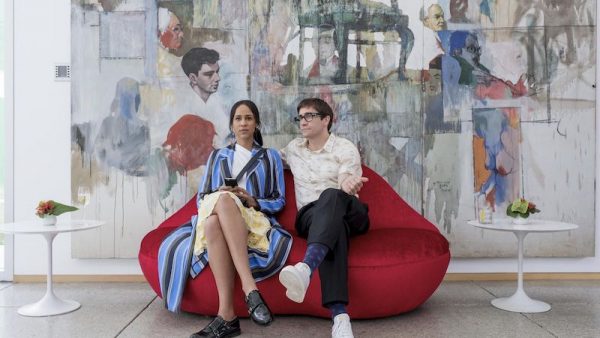

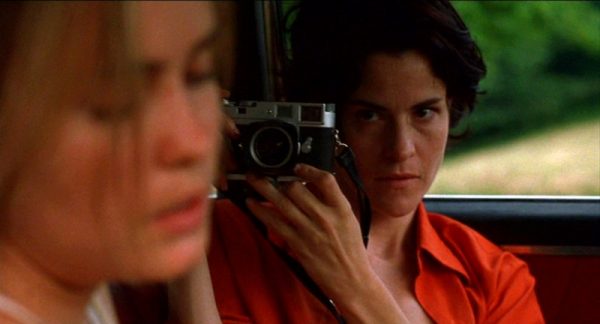

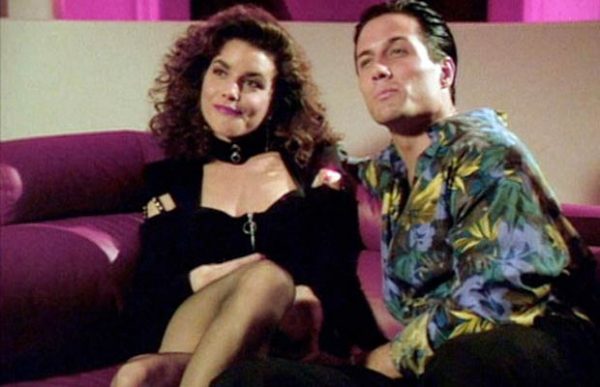
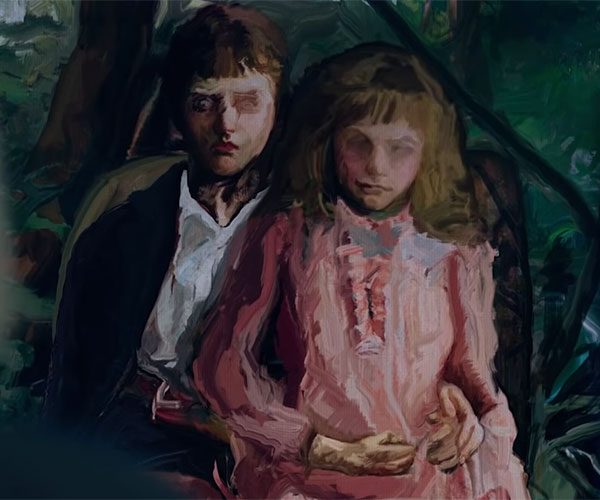
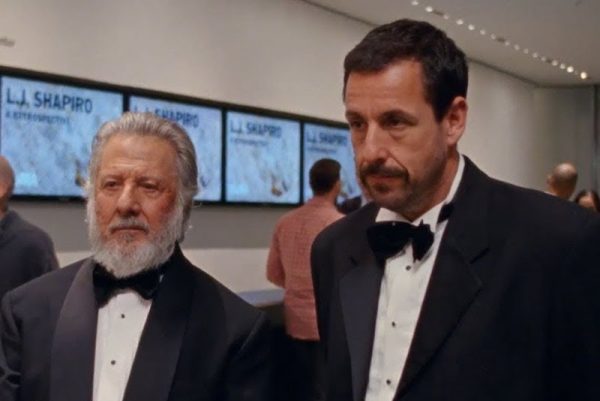


12 comments
Mark Flood made this movie in 2015: Art Fair Fever.
The Horse’s Mouth, 1958
I thought Laurie Simmons’ My Art was pretty good and it solved the problem of showing good art in a fiction film by having a good artist make the art (Simmons herself and in a scene where Simmons’ character meets up with a more successful artist, the art is Marilyn Minter’s). But using good art by real artists is no guarantee the movie will otherwise be any good–for example, Catchfire (aka Backtrack), a terrible movie directed by Dennis Hopper (who took his name off the movie–it’s officially and “Alan Smithee” movie) and starring Jodi Foster playing essentially a fictional Jenny Holzer. Boogie Woogie is another pretty bad movie (but better than Catchfire) with a great cast and quite good art in it.
Boogie Woogie, 2009. Dark satire about the art world. Everybody gets skewered–dealers, collectors, artists, gallery girls. An excellent cast.
And one more thing, the idea of a critic screwing up a high-dollar sale is as you both suggest utterly laughable. Don Thompson, by looking at years worth of auction data, demonstrated empirically that critics had effectively no pricing power in the world of blue-chip art (see his book The 12 Million Dollar Stuffed Shark). Not that I would expect a filmmaker to know this.
Artists of most kinds – composers in particular – have almost always been poorly served by the cinema because of the ‘flash of genius’ cliche, the flash that can’t be caught onscreen. The composer sits, melancholy, noodling on the piano – and then is instantly inspired to be Cole Porter or Mozart or Beethoven. No real work involved but, of course, lots of suffering.
Even journalists have laughed for years at the way reporters are portrayed (the young female journalist in ‘House of Cards’ who got a single, anonymous-sourced expose into the Washington Post – yeah, editors let that happen far too often). The portrayal of the imperious, all-powerful critic goes hand in hand with such idiocy. (Most accurate newspaper movie, hands down: ‘Spotlight.’ BEST newspaper movie, hands down: ‘His Gal Friday’ – in which the only reporter with affectations of ‘arts and literature’ is soundly mocked and given a job that doesn’t exist in order to get rid of him.)
But if you want ca-RAZY portraits of creative types look no further than director Ken Russell’s entire ouevre (Lisztomania, Mahler, Valentino, Clouds of Glory (about Coleridge and Wordsworth)). Still, I’d think visual artists would provide better cinematic source material for the obvious reason: You’ve got visuals of them BEING creative. Yet they get mostly treated as the same sort of incomprehensible visionary genius and/or intolerable asshole.
So oddly enough, Russell’s ‘Savage Messiah’ (about the sculptor Henri Gaudier-Brzeska) would be one of my choices for a good ‘portrait of the artist as a young man’ (despite the overheated title) but I confess I haven’t seen it in years. Don’t know how well it holds up. Others on my list: ‘The Draughtsman’s Contract’ (in fact, that’s on the TOP of my list – a must-see), “Mr. Turner,” “I Shot Andy Warhol,” “The Horse’s Mouth,” “Art School Confidential” and “Goya in Bourdeaux.’
I’m a little surprised no one’s mentioned “Pollock” – which I’d have to see again, frankly, it’s been 20 years – or “Frida” or ‘My Left Foot’ – ditto. It’s been a couple decades since I’ve seen them as well. But I think the general consensus that the art world has been better served by documentaries is absolutely accurate: ‘Tim’s Vermeer,’ ‘Exit through the Gift Shop,” “Basquiat” and “National Gallery.”
Good list! (PS: I do mention Pollock in the conversation.)
Have you tried “Zodiac” starring, coincidentally, Jake Gyllenhaal? Another great movie about journalism and the futile obsession with knowing the unknowable.
Ah. Apologies. I had to search through it carefully again to catch the reference to Ed Harris’ performance.
Not mentioned: Pecker by John Waters
I just remembered a movie called (Untitled) (2009) with Adam Goldberg. I saw it with my mom in the theater. It wasn’t great, but it was worth a few laughs, and it visits the familiar territory of the artist who flails under his own ‘integrity’ (Goldberg) while his brother, the dumb one, makes embarrassingly easy paintings and also makes bank. The gallerist who shows them both is proud of the street cred of Goldeberg’s character while keeping her gallery afloat on the under-the-table sales of the dumb brother’s paintings.
https://youtu.be/rUxgPt4k3RY
“and her boyfriend stache, they’re both artists”